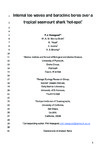Internal lee waves and baroclinic bores over a tropical seamount shark ‘hot-spot’
| dc.contributor.author | Hosegood, Philip | |
| dc.contributor.author | Nimmo-Smith, Alex | |
| dc.contributor.author | Proud, R | |
| dc.contributor.author | Adams, K | |
| dc.contributor.author | Brierley, AS | |
| dc.date.accessioned | 2019-01-22T09:58:14Z | |
| dc.date.issued | 2019-03 | |
| dc.identifier.issn | 0079-6611 | |
| dc.identifier.uri | http://hdl.handle.net/10026.1/13205 | |
| dc.description.abstract |
Oceanographic observations were made with a subsurface oceanographic mooring over the summit and flanks of two neighbouring seamounts in the tropical Indian Ocean to identify processes that may be responsible for the aggregation of silvertip sharks (Carcharhinus albimarginatus) in the deep water drop-off surrounding the summits. The seamounts, which are in the Chagos Archipelago in the British Indian Ocean Territories, are narrow in horizontal extent (<10 km), have steeply sloping (>15°) sides that rise from depths of > 600 m, and flat summits at a depth of 70 m. They are subjected to forcing at subinertial, basin-scales and local scales that include a mixed tidal regime and storm-generated near inertial waves. At the drop-off, at a depth of between 70 and 100 m, isotherms oscillate at both diurnal and semidiurnal frequencies with amplitudes of ∼ 20–30 m. The waves of tidal origin are accompanied by short period (∼5 min) internal waves with amplitudes O(10 m) and frequencies close to the local buoyancy frequency, N, within the thermocline which is the maximum frequency possible for freely propagating internal waves. The tidal oscillations result from internal lee waves with 30 m vertical wavelength generated by the prevailing currents over the supercritical seamount flanks, whereby the bottom slope is greater than the internal tide wave slope. The ‘near-N’ waves are due to enhanced shear associated with the hydraulic jumps that form from the lee waves due to the abrupt transition from steeply sloping sides to a relatively flat summit. The jumps manifest themselves as bottom-trapped bores that propagate up the slope towards the summit. Further observations over the summit reveal that the bores subsequently flush the summits with cold water with tidal periodicity. The bores, which have long wave phase speeds more than double that of the bore particle velocities, are characterised by intense vertical velocities (>0.1 m s −1 ) and inferred local resuspension but relatively little turbulence based on temperature overturns. Our results strongly implicate lee waves as the dynamic mechanism of leading order importance to the previously observed accumulation of biomass adjacent to the supercritical slopes that are commonplace throughout the archipelago. We propose that further investigation should identify the spatiotemporal correlation between internal wave activity and fish schooling around the summit, and whether such schooling attracts predators. | |
| dc.format.extent | 34-50 | |
| dc.language | en | |
| dc.language.iso | en | |
| dc.publisher | Elsevier | |
| dc.rights | Attribution-NonCommercial-NoDerivatives 4.0 International | |
| dc.rights | Attribution-NonCommercial-NoDerivatives 4.0 International | |
| dc.rights | Attribution-NonCommercial-NoDerivatives 4.0 International | |
| dc.rights | Attribution-NonCommercial-NoDerivatives 4.0 International | |
| dc.rights.uri | http://creativecommons.org/licenses/by-nc-nd/4.0/ | |
| dc.rights.uri | http://creativecommons.org/licenses/by-nc-nd/4.0/ | |
| dc.rights.uri | http://creativecommons.org/licenses/by-nc-nd/4.0/ | |
| dc.rights.uri | http://creativecommons.org/licenses/by-nc-nd/4.0/ | |
| dc.subject | Chagos Archipelago | |
| dc.subject | Indian Ocean | |
| dc.subject | Lee waves | |
| dc.subject | Seamount | |
| dc.subject | Apex predators | |
| dc.subject | Internal waves | |
| dc.title | Internal lee waves and baroclinic bores over a tropical seamount shark ‘hot-spot’ | |
| dc.type | journal-article | |
| dc.type | Journal Article | |
| plymouth.author-url | https://www.webofscience.com/api/gateway?GWVersion=2&SrcApp=PARTNER_APP&SrcAuth=LinksAMR&KeyUT=WOS:000460493500003&DestLinkType=FullRecord&DestApp=ALL_WOS&UsrCustomerID=11bb513d99f797142bcfeffcc58ea008 | |
| plymouth.volume | 172 | |
| plymouth.publication-status | Published | |
| plymouth.journal | Progress in Oceanography | |
| dc.identifier.doi | 10.1016/j.pocean.2019.01.010 | |
| plymouth.organisational-group | /Plymouth | |
| plymouth.organisational-group | /Plymouth/Faculty of Science and Engineering | |
| plymouth.organisational-group | /Plymouth/Faculty of Science and Engineering/School of Biological and Marine Sciences | |
| plymouth.organisational-group | /Plymouth/PRIMaRE Publications | |
| plymouth.organisational-group | /Plymouth/REF 2021 Researchers by UoA | |
| plymouth.organisational-group | /Plymouth/REF 2021 Researchers by UoA/UoA07 Earth Systems and Environmental Sciences | |
| plymouth.organisational-group | /Plymouth/Research Groups | |
| plymouth.organisational-group | /Plymouth/Research Groups/Marine Institute | |
| plymouth.organisational-group | /Plymouth/Users by role | |
| plymouth.organisational-group | /Plymouth/Users by role/Academics | |
| plymouth.organisational-group | /Plymouth/Users by role/Researchers in ResearchFish submission | |
| dcterms.dateAccepted | 2019-01-22 | |
| dc.rights.embargodate | 2020-1-25 | |
| dc.rights.embargoperiod | Not known | |
| rioxxterms.versionofrecord | 10.1016/j.pocean.2019.01.010 | |
| rioxxterms.licenseref.uri | http://creativecommons.org/licenses/by-nc-nd/4.0/ | |
| rioxxterms.type | Journal Article/Review |



